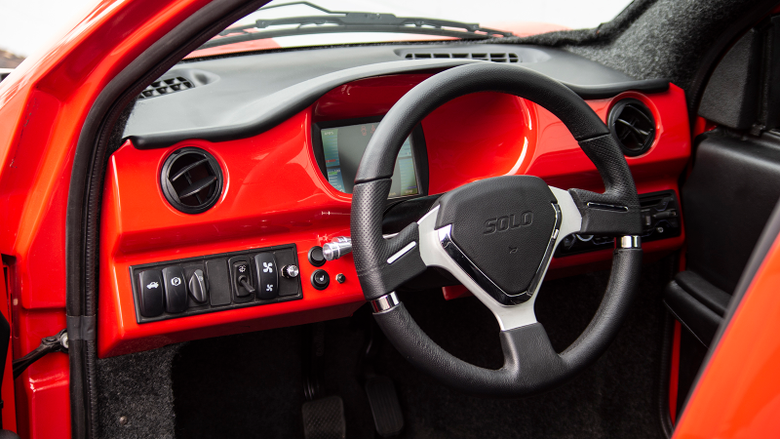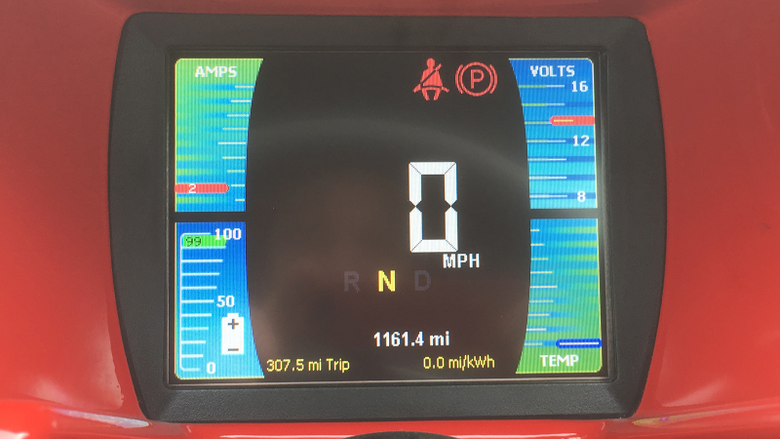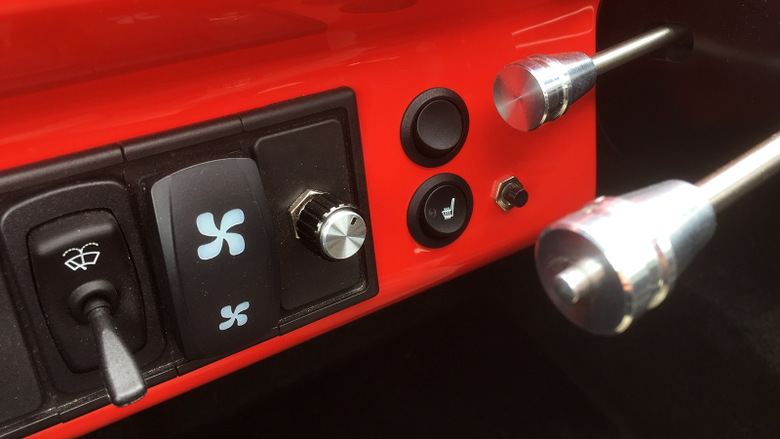The Electra Meccanica Solo Is A Supercar For Efficiency Freaks
Hustling the Electra Meccanica Solo up Mulholland Drive took a lot more arm muscle than I expected. Something else surprised me too—I didn't feel like I was going to die. This early version of a small-batch stiletto-shaped microcar is unrefined in some ways, but it definitely made for a memorable driving experience.
(Full disclosure: A PR agency representing Electra Meccanica asked if I wanted to see the company's dealership in nearby Studio City and drive the Solo. I said yes. Free coffee was also provided.)
The Solo looks just as outlandish in person as it does in pictures. Walking among a little family of them nesting at the company's new dealership just north of Los Angeles, I had trouble thinking of intelligent questions because I was too distracted by dumb ones. What... the hell? Where's the rest of it?

The answer to Where did the rest of the car go is pretty simple: It's a lot less complicated and costly to launch a new car company if your "car" isn't legally a car at all. The Electra Meccanica Solo is technically a three-wheeled single-passenger vehicle that can be classified as a motorcycle.
Sound familiar? There are two other new electric vehicle companies I can think of off the top of my head leveraging the same strategy: Arcimoto and Elio. Both outfits promise cheap, three-wheeled alternatives to normal cars and will take your money for a reservation right now but. (Electra Meccanica and Arcimoto's deposits are refundable, Elio advertises a tiered deposit system with some refundable options.)
Elio, as regular Jalopnik readers will remember, has been breaking promises and failing to mass-produce a product since we started covering the company in [checks notes] 2015.
I rode Arcimoto's semi-enclosed motorcycle/car thing in 2017, but you still can't quite go out and cop one. A company rep told me that people with pre-orders on the West Coast will start to get vehicles in June, and more regular retail sales will start happening "later this summer." For people in other regions, if you placed an order today, "would estimate delivery in about one year."
Electra Meccanica is selling the Solo on a similar refundable-reservation system, stating vehicle deliveries will start in the second half of 2019 but qualifying that as an estimate. Even the list price is asterisked as an "anticipated" MSRP of $15,500. But the dealership I visited looked pretty nice!
Specs That Matter
The Solo is a scant 122 inches long, 52 inches wide and 53 inches tall. The spec sheet says it's estimated weight is just 1,488 pounds, so its AC electric motor making a claimed 82 horsepower and 128 ft-lbs of torque can actually feel pretty punchy.
It's powered by a 17.4 kWh lithium-ion battery, which Electra Meccanica says is supposed to be good for a 100-mile range and recharge on 110 volts in six hours, half that time if you've got a 220 volt plug.
Cargo storage space does exist; there's plenty of room for a week's worth of groceries as long as you don't have a big family.
The final production version of the Solo is supposed to have a fairly refined dashboard, power brakes and power steering. The early build I took a hot lap around LA in did not.
Electra Meccanica's based in Vancouver, says it will build Solos in China, and plans to sell them in a few urban areas on the West Coast initially.
Like A Roller Skate You Can Ride In
Opening a door of the single-passenger Solo–on either side, because why not–is the only part of the experience that really feels like operating any other car. Once the door's open, you drop in and down like you're driving a supercar. Or a carnival ride.
After being installed in the driver's seat and pulling a door shut, you're wrapped with a primitive but reasonably well-organized interior. I already mentioned my test car was an early build, and Electra Meccanica's rep assured me that the car would get a more advanced and elegant set of controls. But the Solo I drove felt like a small-batch high performance car from the days before anyone could imagine driving such a thing regularly. To be honest, I kind of liked it that way.
In terms of finish, the Solo actually reminded me a lot of a Tesla Roadster I drove in 2007. The idea's cool enough to forgive an unrefined execution, at least at a $15,500 list price.
Once I powered out onto the road–carefully, so as to avoid bottoming out–the Solo felt even more like a classic sports car. The steering wheel had a lot of resistance in it, and the brakes demanded a very heavy input to go to work. Squeeze the other pedal and the Solo accelerates competently enough. It's nowhere near as gut-suckingly exciting as a Tesla or even as explosive as—I can't believe I'm writing this—a Chevy Bolt.
Interestingly, the Solo coasts when you come off the go-pedal, instead of grinding to a halt. Regenerative braking was deemed too expensive and heavy to haul around in this thing, so Electra Meccanica has forgone the feature. The car's so aerodynamic and light that it has a decent claimed range without it, anyway.
The Solo's manufacturers claim the little demi-car can go from 0 to 60 mph in about eight seconds, but it will take much less time to catch the attention of literally everyone you pass. I've never had so many fingers and iPhones pointed my direction, and I once drove a yellow Mercedes G500 4x4 Squared when it was the only one in America.
One fun side effect of having an inexpensive and environmentally conscious car that looks this unique is that you get to be conspicuous without people assuming you're an asshole. That's probably the Solo's most remarkable accomplishment.
And for what it's worth, most of the other motorists and pedestrians peeping me seemed to be laughing with me...
Once you sneak off Main Street, the non-power steering Solo is pretty fun to hustle up a twisty stretch of Mulholland Drive. Again, later cars are supposed to be more modernized and easier to use, but I can only tell you about my experience in the prototype. If you, like most driving enthusiasts, equate steering effort with fun, this early version of the three-wheeler's pretty great. The prototype's brakes were similar: very precise, a little laborious to use.
But the Solo isn't really designed to be a performance car. It's an automobile alternative for people who want to get around an urban area inexpensively, while advertising to the world that they're on the bleeding edge of transportation technology.
For that purpose, the Solo is pretty much perfect. You could spend less on a used electric car from an established automaker, but you're not going to break any necks rolling by in a Nissan Leaf. Or even a dual-motor Tesla, for that matter. Few vehicles stand out as much as a Solo, in spite of/because of its size, and you're definitely not going to make as much of a scene and anything else that costs less than $20,000.
Is That Thing Safe?
If you do have the misfortune of crashing a Solo, you probably already knew or guessed that the three-wheeler isn't held to the same standards as a regular four-wheeled car. And apparently it lives in a grey area in which it's not quite a motorcycle either, so you can drive it on the road without wearing a helmet.
"You don't need a helmet because you're in the helmet," each of Electra Meccanica's reps exclaimed to me. As for how strong that "helmet" is, the company had the vehicle crash-tested by Canadian safety outfit PMG Testing Labs which concluded that the Solo "withstood 20,617 pounds of force applied to the vehicle door, as compared to the 2,977-pound required minimum" per a press release. But Electra Meccanica and PMG's people both separately declined to elaborate on what that actually means, practically speaking.
Unfortunately, that makes it hard to empirically compare crash survivability in the Solo compared to a regular car. But, I mean, logic dictates more bodywork and more airbags equates to more safety.

I don't think it's likely we will ever see comprehensive crash testing that definitively benchmarks the Solo against traditional cars, so I'd advise you drive it like you'd ride a motorcycle: defensively, assuming nobody sees you. Did I mention that already?
As for the drive itself, it feels secure. On a few turns I took a little too fast for comfort, I never felt like the Solo was in danger of tumbling onto its side. The most challenging part of driving is remembering not to straddle potholes and tumbleweeds of trash, because of course, you can't.
But despite looking different from anything else on the road, the Solo's fish-like profile hides between SUVs in traffic disconcertingly often. I don't mind repeating this a few times, but driving this car requires the same attitude all motorcyclists should have all the time: Assume you're invisible and drive accordingly.
Early Verdict
The Solo is novel, obviously, and just practical enough to justify its $15,500 anticipated list price for the people who will find its unorthodox concept appealing. It's not fast, but it is fun.
You don't have to stare at any of LA's busy roads for long to understand the frustration that forged the idea for the Solo in the first place. Almost every car, whether it's a Corvette or a Prius or a Range Rover or anything else, is dragging one person around in its big metal body. (And most of them grease themselves into "compact" parking spots without a second thought, too.)
If Angelinos bought exactly the car they needed, I bet a lot of people would realize a Solo kind of makes a lot of sense. But Los Angeles is particularly adept at reminding you that Americans are addicted to putting "wants" over "needs." Mass-adoption of the Solo is unlikely. But for people who want to make a statement, people who want to drive something different, and people who really appreciate extreme efficiency in more sense than one, the Solo is all kinds of excellent.







